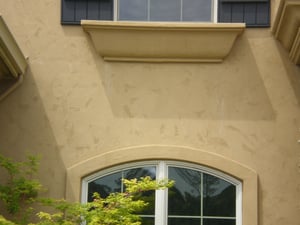
Did you know that stucco, also known as exterior plaster, has been used for many centuries? Historians suggest that the material has been used by multiple civilizations including the Babylonians, Greeks, Egyptians, and Romans, spanning over thousands of years.
Although evolved and changing, the use of stucco today is still growing in popularity despite various problems. The following is a short comparison of historic and new practices.
Historic structures still standing today indicate that “old” stucco material was used and its construction was “done right”. Its original composition and performance appears superior compared to its modern-day counterpart.
Why did the historic stucco used in buildings last so long and perform so well?
- Traditional stucco was lime based and consisted of three layers – the scratch, brown, and finish coats.
- Due to the historic stucco’s chemical properties, it was durable. With its successive layers of permeability, incidental moisture could escape allowing the wall system to dry out (breathe).
- The substrate used for the stucco was durable and far less susceptible to damage due to moisture intrusion.
- Without current insulation requirements, the continuous air movement and energy flow helped wall systems dry out and, therefore, last longer.
Modern stucco evolved and got more sophisticated, or did it?
- Polymers were added to get better strength, however, this resulted in changes in the stucco’s density and its ability to “breathe”.
- We know that wood products absorb water and if unable to dry out, they tend to deteriorate. Wood substrates (plywood and then OSB), in combination with other “improvements” introduced to strengthen, save time, and labor costs, often resulted in rot and/or mold growth due to the moisture’s inability to escape.
- Insulation of walls, an energy saving improvement to increase thermal resistance and performance, also inadvertently affected a wall’s ability to dry out.
- Modifications to weather resistive barriers (WRB) to improve dimensional stability and better stucco bonding performance also diminished drying capacity of the exterior wall and exacerbated component damages.
- Initially these product component alterations and/or combinations did not serve well the construction community, however, their use provided new insight.
So what did we learn and where are we now?
- By observing damages from past stucco failures we have learned the importance of good moisture management and better construction practices.
- The introduction of drainage mats, better WRB products, and the addition of air gaps have helped enhance modern day stucco performance.
- With continuous research into better stucco systems and compatibility of components many manufacturers have made great strides in improving their products and installations.
- The Building Industry and Code Authorities also continually strive to introduce higher standards, better testing methods, and regulations for product and construction improvements.
- Building materials keep evolving as well as our knowledge of what works well and what does not.
Interested in more information on stucco? Other resources include:
- The Preservation and Repair of Historic Stucco. Anne Grimmer, U.S. Department of the Interior National Park Service. Preservation Assistance Division
- PCA, America’s Cement Manufacturers™
- Portland Cement Association. Repair of Portland Cement Plaster (Stucco)
- Plaster’s Manual
- The Preservation and Repair of Historic Stucco



